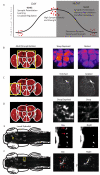Synaptic plasticity in sleep: learning, homeostasis and disease
- PMID: 21840068
- PMCID: PMC3385863
- DOI: 10.1016/j.tins.2011.07.005
Synaptic plasticity in sleep: learning, homeostasis and disease
Abstract
Sleep is a fundamental and evolutionarily conserved aspect of animal life. Recent studies have shed light on the role of sleep in synaptic plasticity. Demonstrations of memory replay and synapse homeostasis suggest that one essential role of sleep is in the consolidation and optimization of synaptic circuits to retain salient memory traces despite the noise of daily experience. Here, we review this recent evidence and suggest that sleep creates a heightened state of plasticity, which may be essential for this optimization. Furthermore, we discuss how sleep deficits seen in diseases such as Alzheimer's disease and autism spectrum disorders might not just reflect underlying circuit malfunction, but could also play a direct role in the progression of those disorders.
Copyright © 2011 Elsevier Ltd. All rights reserved.
Figures


References
-
- Aserinsky E, Kleitman N. Regularly occurring periods of eye motility, and concomitant phenomena, during sleep. Science. 1953;118:273–274. - PubMed
-
- Jouvet M, et al. On a stage of rapid cerebral electrical activity in the course of physiological sleep. C R Seances Soc Biol Fil. 1959;153:1024–1028. - PubMed
-
- Carskadon MA, Dement WC. Normal Human Sleep: An Overview. Principles and Practice of Sleep Medicine. 2005:13–23.
-
- Tobler I. Effect of forced locomotion on the rest-activity cycle of the cockroach. Behav Brain Res. 1983;8:351–360. - PubMed
-
- Campbell SS, Tobler I. Animal sleep: a review of sleep duration across phylogeny. Neurosci Biobehav Rev. 1984;8:269–300. - PubMed
Publication types
MeSH terms
Grants and funding
LinkOut - more resources
Full Text Sources
Other Literature Sources
Medical

